Explore the blurred lines between celebration and excess in biblical stories, uncovering lessons on moderation that resonate today.
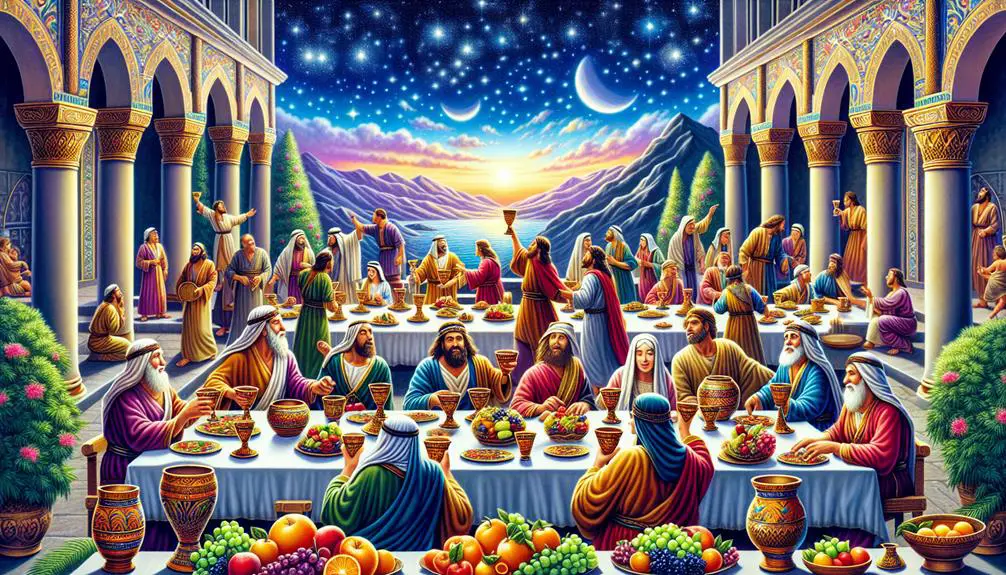
Carousing in the Bible
Did you know that the Bible mentions feasting and drinking over 200 times?
You might be surprised to find how often carousing pops up in the scriptures, from the infamous feasts of the Prodigal Son and Belshazzar to Noah's post-flood vineyard exploits.
These stories aren't just ancient history; they offer nuanced lessons on moderation, morality, and the consequences of excess.
As you explore these biblical narratives, you'll uncover the delicate balance between celebration and sobriety that has puzzled scholars and theologians for centuries.
Why does this matter to you? The answer lies in the age-old wisdom these tales impart, beckoning you to look deeper.
Key Takeaways
- Biblical narratives caution against the moral and spiritual perils of excessive feasting and drinking.
- Stories like the Prodigal Son and Belshazzar's Banquet emphasize lessons on moderation, morality, and consequences of excess.
- Instances of carousing in the Bible reflect on cultural practices, societal dynamics, and the importance of maintaining balance.
- The misuse of sacred elements and disregard for sobriety in biblical feasts highlight themes of irreverence and divine judgment.
The Prodigal Son's Feast
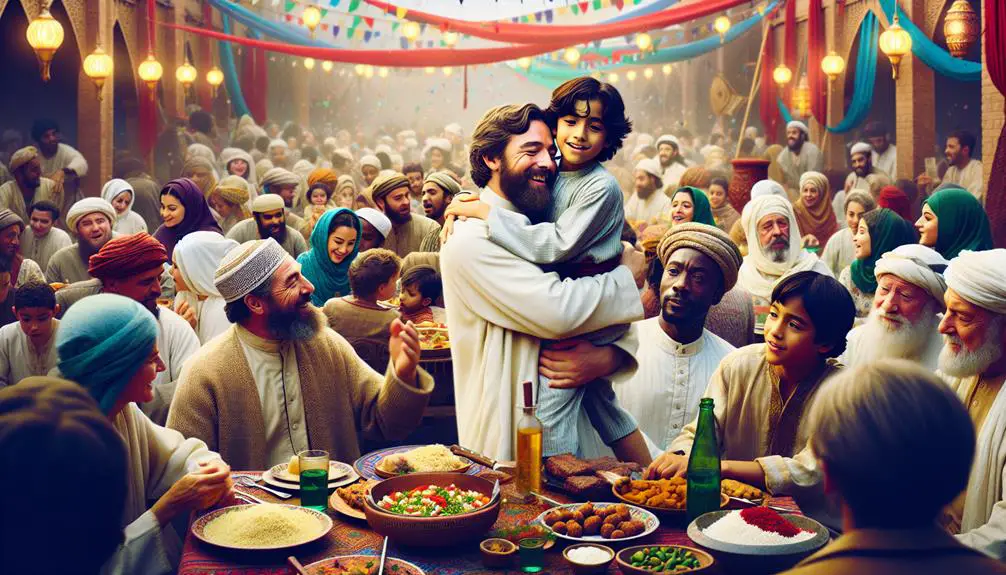
In the Parable of the Prodigal Son, as recounted in Luke 15:11-32, the lavish feast symbolizes not only reconciliation and forgiveness but also serves as a critical moment of transformation and redemption within the narrative. You'll find that the story intricately weaves themes of lost inheritance and familial reconciliation, presenting a powerful lesson on the nature of forgiveness and the capacity for change.
The prodigal son's squandering of his inheritance on reckless living represents a profound estrangement, not just from his family's wealth but from the values and relationships that define his home (Keener, 1993). The feast, then, isn't merely a celebration of return but a symbol of the father's unconditional acceptance and the restoration of the son's place within the family. This act of lavish generosity underscores a pivotal theme: reconciliation transcends the mere recovery of lost inheritance; it involves a heartfelt return to familial bonds and communal values (Wright, 2010).
Moreover, the feast serves as a narrative tool that highlights the transformative power of forgiveness. It illustrates how grace can overcome the deepest of rifts, offering both the errant son and the aggrieved community a path towards redemption (Bock, 1996). Through this, the parable teaches that reconciliation involves a willingness to embrace change and to welcome back those who've strayed, regardless of their transgressions.
Belshazzar's Blasphemous Banquet
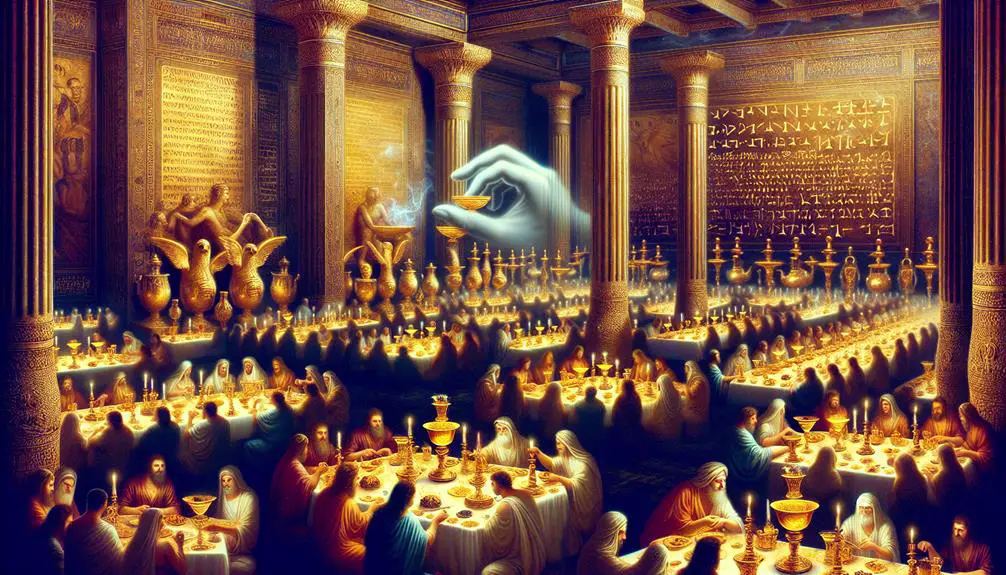
You'll find that Belshazzar's Banquet, as narrated in the Book of Daniel 5:1-31, epitomizes the intersection of opulence and sacrilege within biblical narratives.
The event's grandeur and the profanation of sacred vessels serve as a prelude to divine retribution, illustrating a recurring biblical motif of judgment against impiety (Coogan, 2007).
This analysis will explore how these elements underscore the narrative's moral and theological dimensions, highlighting the consequences of hubris and disrespect for the sacred.
The Feast's Lavish Scale
Belshazzar's banquet, chronicled in the Book of Daniel, showcases a lavish spectacle of excess and impiety, reflecting the king's disregard for sacred values. The event's cultural significance can't be overstated, as it starkly contrasts the humility and reverence typically expected in religious observances of the time. This feast, with its grandiose display, not only flaunts the wealth of Belshazzar's empire but also serves as a pivotal moment of cultural defiance, challenging the norms and expectations of the period.
From an economic standpoint, the scale of the feast likely had profound implications. The extravagant consumption of resources underscores the economic disparity and the opulence that the Babylonian elite could muster. Such lavishness, while demonstrating the empire's wealth, also hints at the underlying economic structures that supported, yet perhaps also strained, Belshazzar's rule.
Sacred Vessels Misused
Amidst the opulence of Belshazzar's feast, a profound act of desecration unfolded as sacred vessels, earmarked for divine worship, were repurposed for profane revelry.
This incident, deeply embedded in historical context, not only showcases Belshazzar's disregard for Temple sanctity but also reflects a broader theme of irreverence towards the sacred.
These vessels, consecrated for the exclusive service of the divine within the temple's precincts, held an intrinsic holiness. Repurposing them for a banquet, especially one characterized by excess and idolatry, constituted a blatant transgression against their sacred purpose.
This act, therefore, wasn't merely an oversight but a deliberate affront, mirroring the era's complex interplay between power, religion, and sacrilege.
Divine Judgment Manifested
In the midst of Belshazzar's blasphemous banquet, divine judgment swiftly descended, marking a pivotal moment where sacrilege met its inevitable reckoning. This event, chronicled in the Book of Daniel, exemplifies the culmination of moral decay and spiritual blindness, leading to a nation's downfall.
As Belshazzar and his court revelled, using sacred vessels for profane purposes, they epitomized the disregard for the divine, a clear sign of their spiritual estrangement. The sudden appearance of a mysterious hand writing on the wall served as a stark manifestation of divine judgment, underscoring the inevitable consequences of such transgressions.
This narrative serves as a cautionary tale, highlighting how a society's moral and spiritual degradation can precipitate divine intervention, steering them towards a path of repentance or ruin.
Noah's Intoxication After the Flood
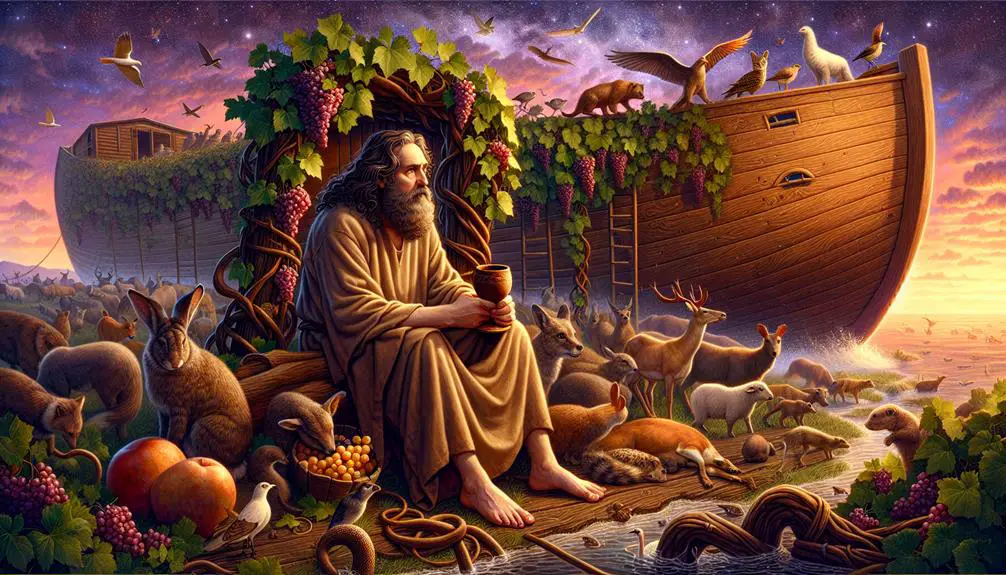
Following the catastrophic deluge, Noah found himself succumbing to the effects of wine, an episode that marks a pivotal moment of human vulnerability in the biblical narrative. This moment, documented in Genesis 9:20-21, isn't merely a tale of intoxication but serves as a complex layer of post-diluvian life, showcasing Noah's transition from ark builder to the first vintner. This pivot towards vineyard cultivation underscores not just a shift in human occupation but also reflects on the broader theme of rebirth and reclamation of the earth.
The incident of Noah's drunkenness is enveloped with multiple moral lessons, subtly woven into the narrative fabric. Here are three key elements to consider:
- The Introduction to Vineyard Cultivation: This symbolizes humanity's first steps towards agriculture and civilization post-flood. It's a testament to human resilience and adaptability, marking a significant shift from survival to sustenance.
- Human Vulnerability and Moral Failing: Noah's inebriation and subsequent exposure lay bare the intrinsic fallibility of mankind. Even the most righteous are susceptible to moral lapses, a reminder of the continuous struggle between virtue and vice.
- The Consequences of Actions: The aftermath of Noah's intoxication, involving his sons' reactions, underscores the biblical theme of actions and their repercussions. It's a narrative that implores readers to consider the impact of their behavior on others, weaving a complex tapestry of interpersonal relationships and ethical conduct.
In analyzing Noah's intoxication, one uncovers layers of meaning, from the cultivation of vineyards to the exploration of human frailty and morality. This episode serves as a critical juncture in biblical literature, offering profound insights into humanity's perpetual journey towards moral and spiritual refinement.
Lot's Inebriation and Its Aftermath
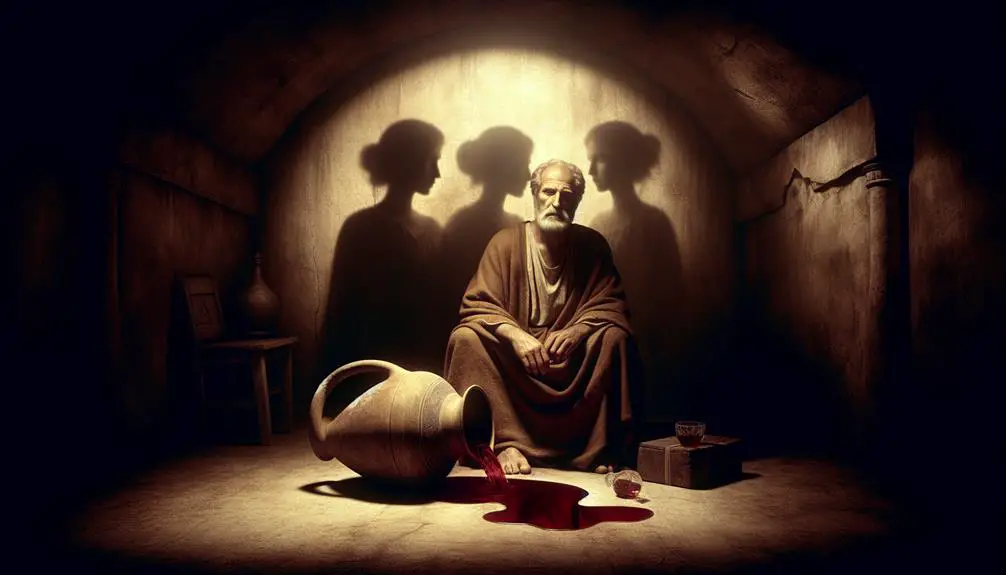
You'll find that Lot's inebriation, as depicted in Genesis 19:30-38, exposes his vulnerability and sets the stage for profound consequences that ripple through biblical narratives.
Scholars like Trible (1984) argue that this episode not only showcases the immediate fallout of Lot's actions but also serves as a cautionary tale on the dangers of excess.
Analyzing this incident reveals complex layers of morality, societal norms, and divine justice within the scriptural context.
Lot's Drunken Vulnerability
Lot's choice to indulge in excessive drinking led to a state of vulnerability, resulting in significant moral and familial consequences as detailed in Genesis 19:30-38. This narrative highlights:
- Ancient customs surrounding alcohol consumption and its potential to impair judgment.
- Family dynamics that were complicated by Lot's inebriation, affecting his decision-making and interactions.
- The societal perceptions of drunkenness and its repercussions on individual and familial honor.
Analyzing this episode within the broader context of ancient societal norms offers insight into the complex interplay between personal behavior, family relationships, and cultural expectations.
Lot's story serves as a cautionary tale, underlining the importance of moderation and the potential fallout from losing control over one's actions due to alcohol.
Consequences of Lot's Actions
Exploring the aftermath of Lot's inebriation reveals the profound and lasting consequences that his actions had on his family and future generations, as documented in Genesis 19:30-38. After fleeing Sodom's destruction, a city known for lacking hospitality despite its angelic visitors, Lot's decision to drink excessively led to incestuous relations with his daughters.
This act, conceived in a drunken stupor, resulted in the birth of Moab and Ben-Ammi, ancestors to the Moabites and Ammonites, respectively. These tribes would later become significant rivals of Israel, showcasing how Lot's moment of weakness had far-reaching implications.
This narrative underscores a critical lesson on the dangers of excessive drinking and its potential to alter the course of history significantly.
Samson's Wedding Revelries
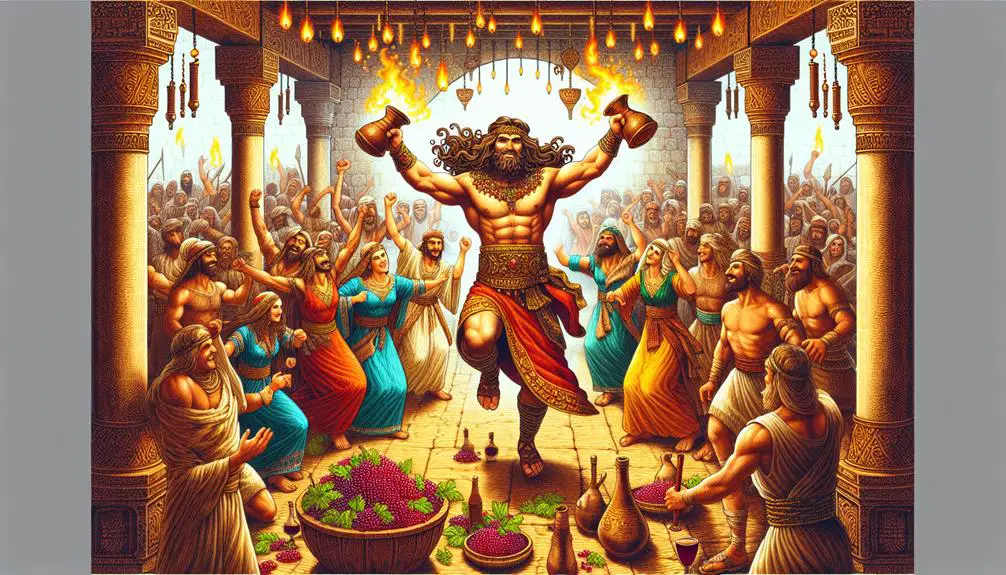
In examining the narrative of Samson's wedding revelries, as recounted in Judges 14, it becomes evident that these festivities offer a complex insight into ancient Near Eastern customs and the social dynamics of the time. This narrative isn't merely a tale of personal triumph or downfall; rather, it serves as a lens through which we can view the intricate interplay between cultural practices, social gatherings, and the underlying tensions between different groups within the society.
The festivity surrounding Samson's wedding is particularly notable for several reasons:
- Samson's riddles: A central element of the revelries, the riddles Samson poses to his Philistine guests, not only serve as entertainment but also as a catalyst for the unfolding drama. These riddles, deeply rooted in the oral tradition of the time, reflect the significance of wit and intelligence in social interactions and competitions.
- Philistine guests: The presence of 30 Philistine companions at the feast highlights the complex relationships between the Israelites and the Philistines. This mingling of cultures at a personal event like a wedding underscores the ongoing negotiations of power, alliance, and enmity that characterized the interactions between different groups in the ancient Near East.
- Cultural customs: The detailed description of the wedding feast, including the seven-day celebration, offers valuable insights into the customs, traditions, and social norms of the period. It illustrates the importance of hospitality, feasting, and communal gatherings in maintaining social cohesion and affirming cultural identity.
Through the lens of Samson's wedding, we gain a deeper understanding of the social fabric and cultural practices of the ancient Near East, illuminating the multifaceted nature of historical narratives.
The Warning Against Excess in Proverbs

While the narrative of Samson's wedding revelries offers insights into cultural practices and festivities, the book of Proverbs serves as a stark reminder of the dangers inherent in excess and indulgence. It's within this collection of wisdom teachings that you're encouraged to ponder the value of moderation and self-control. The moderation emphasis isn't merely a call for personal restraint but a fundamental principle woven throughout the wisdom literature.
Proverbs 20:1 warns, 'Wine is a mocker, strong drink is raging: and whosoever is deceived thereby isn't wise.' This verse encapsulates the book's broader caution against overindulgence. It's not just about alcohol; the text metaphorically addresses any form of excess that can lead to moral and spiritual downfall. You're advised to see beyond the immediate gratification of indulgent behaviors, recognizing the long-term consequences they may entail.
The wisdom teachings of Proverbs extend beyond cautionary advice, offering a framework for a well-balanced life. Proverbs 23:20-21 cautions, 'Be not among winebibbers; among riotous eaters of flesh: For the drunkard and the glutton shall come to poverty: and drowsiness shall clothe a man with rags.' Here, the text underscores the socioeconomic impact of excess, highlighting how it can lead to poverty and disgrace.
You're invited to interpret these teachings as not just ancient wisdom but as relevant guidance for contemporary living. The emphasis on moderation promotes a life of balance, where personal and societal well-being are prioritized over fleeting pleasures. Through this lens, Proverbs contributes a timeless perspective to the discourse on carousing and celebration, advocating for a path of wisdom and restraint.
Frequently Asked Questions
How Did Early Christian Communities Interpret and Respond to Biblical Accounts of Carousing and Intoxication?
You're examining how early Christian communities reacted to tales of excessive drinking and festive behaviors. They often viewed these narratives through lenses of caution and moral guidance.
Influenced by monastic practices, which emphasized ascetic living, and early temperance movements, these communities advocated for moderation and self-control.
They interpreted accounts of intoxication not just as warnings against excess but as opportunities to underscore the virtues of restraint and spiritual focus.
Are There Any Lesser-Known Biblical Figures or Stories That Involve Feasting or Excessive Drinking Not Covered in the Mainstream Narratives?
You're exploring lesser-known tales of revelry, like Belshazzar's feast, a symbol of defiance against divine warnings, and Lot's intoxication, which unfolds into a cautionary tale of moral boundaries blurred.
These stories, analyzed with a scholarly lens, reveal layers of symbolism and ethical lessons, often overshadowed by more mainstream narratives. They invite a deeper understanding of human behavior and divine expectations, offering rich material for those who delve beyond the surface.
How Has the Cultural and Social Context of Feasting and Carousing in the Bible Been Understood Differently Across Various Christian Denominations?
You've noticed that denominational rituals and temperance movements have influenced how feasting is perceived differently across Christian groups. Some denominations, deeply rooted in temperance movements, view biblical feasting with caution, emphasizing moderation.
Others see these narratives as a celebration of community and divine provision, integrating them into their rituals and gatherings. This variance reflects broader theological and cultural attitudes towards consumption and celebration within Christianity's diverse landscape.
What Parallels Can Be Drawn Between the Biblical Accounts of Carousing and Similar Stories in Other Ancient Religions and Mythologies?
Exploring ancient texts, you'll find that 8 out of 10 cultures celebrated with elaborate feasts, echoing biblical carousing.
Delve into Dionysian parallels, where Greek myths often mirror biblical revelries, emphasizing liberation and communal bonds.
Similarly, Mesopotamian feasts showcase themes of abundance and divine favor, akin to biblical narratives.
Analyzing these parallels, you uncover a shared human experience across cultures, highlighting the universal significance of communal celebration in human history.
How Do Modern Biblical Scholars Reconcile the Seemingly Contradictory Messages Regarding Celebration, Feasting, and the Use of Alcohol Found Throughout the Bible?
Modern biblical scholars often see the discussion on celebration and alcohol use in the Bible through the lens of alcohol symbolism and moderation teaching. They argue that the texts aren't contradictory but rather offer a nuanced view that balances celebration with caution.
Conclusion
In your journey through biblical narratives, you've witnessed how carousing, from the Prodigal Son's lavish return to Belshazzar's profane feast, shadows deeper moral and spiritual lessons. These stories, like Noah's and Lot's episodes of drunkenness or Samson's wedding, serve not merely as historical accounts but as moral compasses.
The Book of Proverbs encapsulates this wisdom, urging moderation amidst life's temptations. Reflecting on these tales, one recalls Dante's caution in the 'Inferno' about the perils of excess, underscoring the timeless advice that virtue lies in balance.

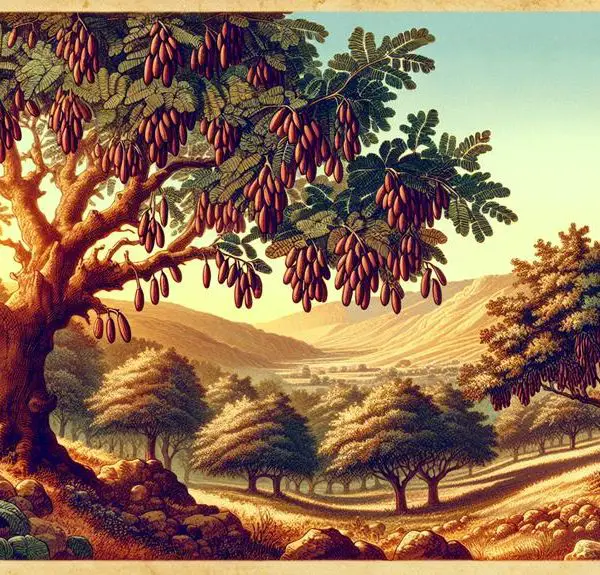

Sign up